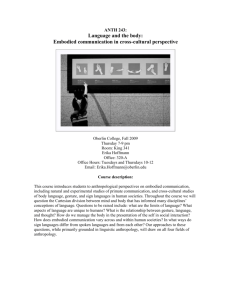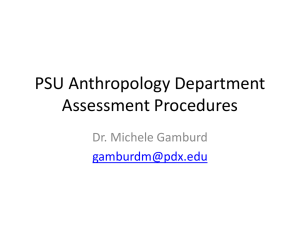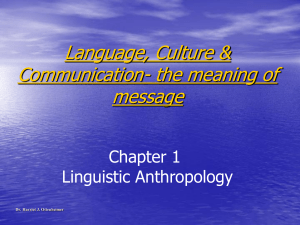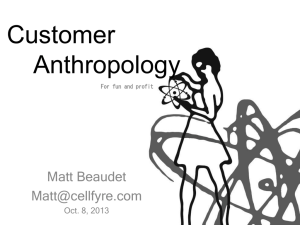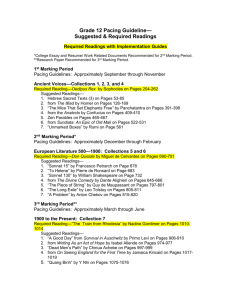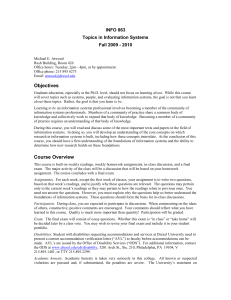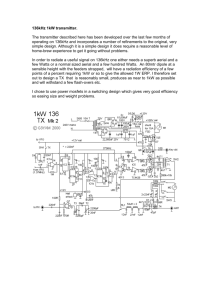Readings
advertisement
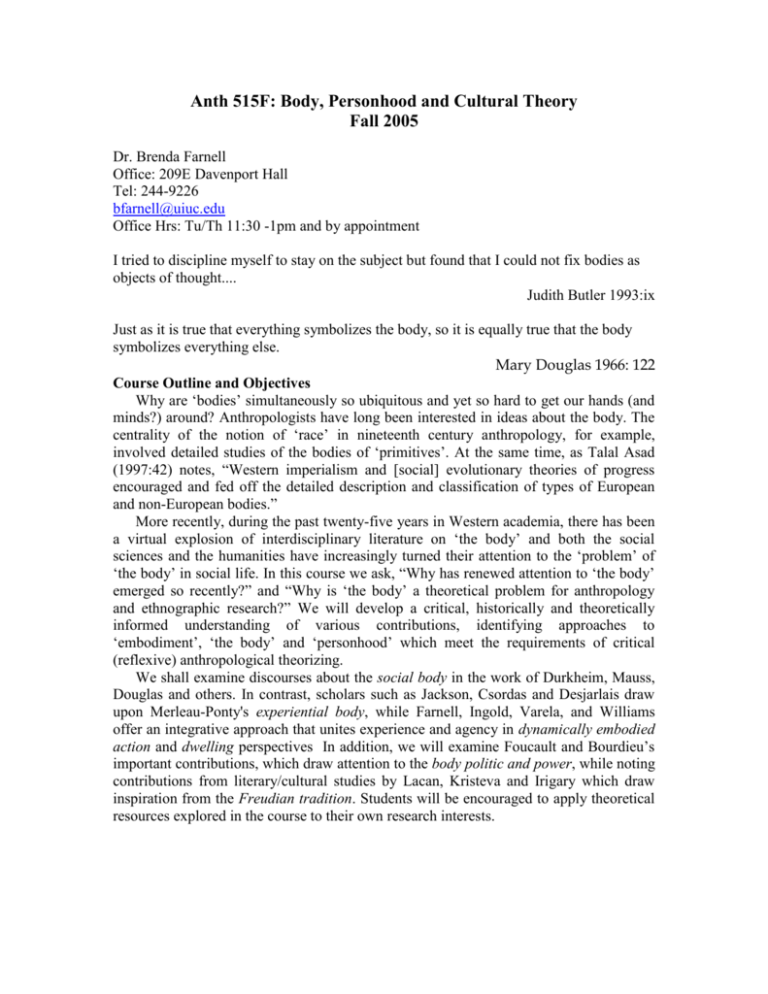
Anth 515F: Body, Personhood and Cultural Theory Fall 2005 Dr. Brenda Farnell Office: 209E Davenport Hall Tel: 244-9226 bfarnell@uiuc.edu Office Hrs: Tu/Th 11:30 -1pm and by appointment I tried to discipline myself to stay on the subject but found that I could not fix bodies as objects of thought.... Judith Butler 1993:ix Just as it is true that everything symbolizes the body, so it is equally true that the body symbolizes everything else. Mary Douglas 1966: 122 Course Outline and Objectives Why are ‘bodies’ simultaneously so ubiquitous and yet so hard to get our hands (and minds?) around? Anthropologists have long been interested in ideas about the body. The centrality of the notion of ‘race’ in nineteenth century anthropology, for example, involved detailed studies of the bodies of ‘primitives’. At the same time, as Talal Asad (1997:42) notes, “Western imperialism and [social] evolutionary theories of progress encouraged and fed off the detailed description and classification of types of European and non-European bodies.” More recently, during the past twenty-five years in Western academia, there has been a virtual explosion of interdisciplinary literature on ‘the body’ and both the social sciences and the humanities have increasingly turned their attention to the ‘problem’ of ‘the body’ in social life. In this course we ask, “Why has renewed attention to ‘the body’ emerged so recently?” and “Why is ‘the body’ a theoretical problem for anthropology and ethnographic research?” We will develop a critical, historically and theoretically informed understanding of various contributions, identifying approaches to ‘embodiment’, ‘the body’ and ‘personhood’ which meet the requirements of critical (reflexive) anthropological theorizing. We shall examine discourses about the social body in the work of Durkheim, Mauss, Douglas and others. In contrast, scholars such as Jackson, Csordas and Desjarlais draw upon Merleau-Ponty's experiential body, while Farnell, Ingold, Varela, and Williams offer an integrative approach that unites experience and agency in dynamically embodied action and dwelling perspectives In addition, we will examine Foucault and Bourdieu’s important contributions, which draw attention to the body politic and power, while noting contributions from literary/cultural studies by Lacan, Kristeva and Irigary which draw inspiration from the Freudian tradition. Students will be encouraged to apply theoretical resources explored in the course to their own research interests. 2 Required Books**: Carrithers, Michael, Steven Collins and Steven Lukes (Eds.).1985. The Category of the Person: Anthropology, Philosophy, History. Cambridge: Cambridge University Press. Desjarlais, Robert R. 1992. Body and Emotion: The Aesthetics of Illness and Healing in the Nepal Himalayas. Philadelphia: U of Pennsylvania Press. Durkheim, Emile and Marcel Mauss 1963. Primitive Classification. London: Cohen & West. Geurts, Kathryn Linn. 2002 Culture and the Senses: Bodily Ways of Knowing in an African Community. Berkeley, Los Angeles, London: University of California Press. Harré, Rom and Grant Gillet. 1993. The Discursive Mind. London: Sage Publications. Shilling, Chris. 1993. The Body and Social Theory. Sage Publications Welton, Donn (ed.). 1999. The Body. Blackwell Readings in Continental Philosophy. Oxford: Blackwell. All the books and paper copies of articles will be on Library Reserve at the Undergraduate Library Media Reserve Desk. The articles will also be available on electronic reserve (go to UIUC Library website, click on Course Reserves, choose professor’s name and/or course number. Click on E-items. Enter your NET ID and password. List of articles will come up – you can download to a disk/travel drive or print. Class Participation: This is a graduate seminar so…. you are expected to come to each meeting having done the selected readings. Our meeting each week will include a lecture component, round table discussions, and presentations. You will be asked to lead some discussions and to present your paper proposal to the class. Please arrive fully prepared to make substantial contributions to the discussion, and to ask questions both during and after my presentations. Written work: A mid semester take home exam (tentative date –week of Oct 24th), a 5-7 page field research paper (due November 17th) and a final research paper due on Dec 15th. Grade Structure: Class participation and preparedness: 15% Mid-term Exam: 30% Field Research paper: 20% Final Paper: 35% Field Research Paper In order to keep our enquiries grounded in bodily practices, you are asked to participate in a bodily practice that is new to you over part of the course of the semester. For example, choose to take a recreational class in an imported form of exercise or meditation such as Yoga, Tai-Chi, TM, Chigong; any of the Martial Arts; a dance form (Tango? Salsa?); an exercise technique such as aerobics, kick-boxing or weight training; a sport; or a new art/craft/skill (Japanese tea ceremony? American Sign Language?) You should plan to make 4-6 visits/classes over the semester. Please keep a diary of your observations and experiences. We will turn this into a 5-7 page paper, applying relevant theoretical resources from our seminar. If you have an alternative idea, just run it by me! ____________________________ **Please note that books for this class are not available from any of the usual bookstores in town. In support of Native American peoples, especially our Native American faculty, staff, students and local community, I will not support stores who also market “chief” merchandise. I recommend getting the texts instead from http://www.addall.com (a website that compares prices 3 from many online sources); Amazon.com; Pages For All Ages Bookstore; or the publisher. Online orders will arrive quickly, often within a week. Weekly Schedule of Topics and Readings August 25 (1) Introduction and Overview Follow Up Readings: (Copies available in Davenport 109, Anthro Computer Lab) Scheper-Hughes Nancy and Margaret Lock. 1987. ‘The Mindful Body’. Medical Anthropology Quarterly 1:6-41. Farnell, Brenda 1994. ‘Ethno-Graphics and the Moving Body’, MAN (JRAI) 29(4): Part 1. Pp 929-937. Kensinger, Kenneth M. 1995. ‘The Body Knows: Cashinahua Perspectives on Knowledge’. In How Real People Ought to Live: The Cashinahua of Eastern Peru. Prospect Heights, Waveland Press, pp 237-246. Recommended Further Resource: Lock, Margaret. 1993. ‘Cultivating the Body: Anthropology and Epistemologies of Bodily Practice and Knowledge’. Annual Reviews of Anthropology 22:133-55 ________________________________________________________________________ September 1 (2) Why ‘the Body’? Why now? Perspectives from Anthropology and Sociology Readings: *Shilling, Chris. 1993. ‘Introduction’. In The Body and Social Theory. London, Thousand Oaks, New Delhi: Sage Publications, pp 1-18. Turner, Brian S. 1996. ‘Introduction to the Second Edition: The Embodiment of Social Theory’. In The Body and Society. London, Thousand Oaks, New Delhi: Sage Publications, pp. 1-36. Turner, Terence. 1986. Review of The Body and Society by Bryan S. Turner [Oxford: Basil Blackwell 1984] American Journal of Sociology 92: 211-213. Turner, Terence. 1994. ‘Bodies and Anti-Bodies: Flesh and Fetish in Contemporary Social Theory’, part 1, pp 27-32. ________________________________________________________________________ Unit I: The Social Body (Discourses about ‘the Body’) September 8 (3) The Durkheimian Legacy – Making the Body Social Readings: Durkheim, Emile. 1938 [1902]. ‘What is a Social Fact?’ In Rules of Sociological Method. New York : Free Press, pp. *Durkheim, Emile and Marcel Mauss. 1963[1903] ‘On Some Primitive Forms of Classification: Contributions to the Study of Collective representations’. In Primitive Classification. R. Needham (Ed.) London: Cohen and West, pp. Mauss, Marcel [1934] 1979. ‘Techniques of the Body’. Reprinted in Incorporations. J. Crary and S.Kwinter (Eds.) New York: Zone Books, pp. 455-477. *Needham Rodney. 1963. Introduction to Primitive Classification. 4 Hertz, Robert. 1973 [1909]. The Preeminence of the Right Hand. In Right and Left: Essays on Dual Symbolic Classification. R. Needham (Ed.) Chicago: U of Chicago Press, pp. 3-31. September 15 (4) The Durkheimian Legacy Continued... Readings: Douglas, Mary. 1966. Purity and Danger. London: Routledge & Kegan Paul, pp. 114-139. 1982 [1970]. Natural Symbols. New York: Pantheon Books, pp. 65-81. Bastien, J. 1985. Qollahuaya-Andean body concepts: a topographical-hydraulic model of physiology. American Anthropologist 87: 595-611. Ellen Roy F. 1977. Anatomical Classification and the Semiotics of the Body. In The Anthropology of the Body. J. Blacking (Ed.) London Academic Press, pp. Sahlins, Marshall. 1977. Colors and Cultures. Semiotica 16:1-22 Choose TWO of the following: Farquhar, Judith. 1987. ‘Problems of Knowledge in Contemporary Chinese Medical Discourse’. Social Science and Medicine 24: 1043-1021 Turner, Terence. 1993 [1980]. ‘The Social Skin’. Reprinted in Reading the Social Body. C. B. Burroughs and J.D. Ehrenreich (Eds.) Iowa City: U of Iowa Press, pp 15-39. Boddy, Janice 1988. Womb as Oasis: The Symbolic Context of Pharaonic Circumcision in Rural Northern Sudan. American Ethnologist 9: 682-98. Devisch, Renaat 1983. ‘Space-time and Bodiliness: A Semantic-praxiological Approach’. In New Perspectives in Belgian Anthropology, or, the Post Colonial Awakening. R. Pinxton (Ed.) Göttingen: Herodot. _______________________________________________________________________ September 22 (5) Freudian Influences Readings: *Lacan, Jacques. Selection. Part II, Section 9 Welton Reader, pp. 213-231. *Bonner, Charles W. ‘The Status and Significance of the Body in Lacan’s Imaginary and Symbolic Orders’. Section 10 Welton Reader, pp. 232-251. *Kristeva, Julia. Selection. Part III, Section 14 Welton Reader, pp. 315-340. Oliver, Kelly. ‘The Flesh become Word: The Body in Kristeva’s Theory’. Welton Reader, pp. 341-352. *Irigary, Luce. ‘Female Desire’. Section 16 Welton Reader, pp. 353-360. Chanter, Tina. ‘Beyond Sex and Gender: On Luce Irigary’s This Sex Which is Not One.’ Section 17 Welton Reader, pp. 361-375. _____________________________________________________________ Unit II. The Individual Body (Discourses of [the experience of] the Body) September 29 (6) The Phenomenology of Embodiment Readings: *Merleau-Ponty, Maurice. Selections. Section 6. Welton Reader, pp150-166. 5 Jackson, Michael. 1989 Paths Toward a Clearing: Radical Empiricism and Ethnographic Inquiry. Bloomington, IN: Indiana University Press. Introduction + chapters 8 & 9; pp 1-18, 119-155. Farnell, B. 1994. Ethno-Graphics and the Moving Body, Part 1. Review pages 936-937. Varela, Charles R. 1995. Cartesianism Revisited: The Ghost in the Moving Machine or the Lived Body. In Human Action Signs in Cultural Context. B. Farnell (Ed.). Metuchen, NJ: Scarecrow Press, pp. 216-293. _____________________________________________________________________ October 6 (7) Cultural Phenomenology Readings: Csordas, Thomas J. 1990. ‘Embodiment as a Paradigm for Anthropology’ Ethos 18: 5-47. 1994a. ‘Introduction: The Body as Representation and Being-in-the-world’. In Embodiment and Experience: The Existential Ground of Culture and Self. T. Csordas (Ed.). Cambridge: Cambridge University Press. 1994b. Words From the Holy People: A Case Study in Cultural Phenomenology. In T. Csordas (Ed.) Embodiment and Experience, pp. 269-290. Ingold, Tim. ‘Culture, Perception and Cognition’. In The Perception of the Environment: Essays in Livelihood, Dwelling and Skill. London: Routledge, pp. 243-287. Varela, Charles. 2004. ‘Harré and Merleau Ponty: Beyond the Absent Moving Body in Embodied Social Theory’. Journal for the Anthropological Study of Human Movement 13(2): 67- 86. _____________________________________________________________________________ October 13 (8) Anthropology of the Senses Readings: Ingold, Tim. 2000. ‘Stop, Look and Listen: Vision, Hearing and Human Movement’. In The Perception of the Environment: Essays in Livelihood, Dwelling and Skill. London: Routledge, pp243-287. Herzfeld, Michael. 2001. Anthropology: Theoretical Practice in Culture and Society. Oxford: Basil Blackwell, pp. 240-277. Farnell, Brenda 2003. Kinesthetic Sense and Dynamically Embodied Action. Journal for the Anthropological Study of Human Movement 12 (4) October 20 (9) The Senses Continued... Readings: Geurts, Kathryn Linn. 2002 Culture and the Senses: Bodily Ways of Knowing in an African Community. Berkeley, Los Angeles, London: University of California Press. 6 **Mid-term Take Home Exam: Due Mon Oct 31st. October 27 (10) Body and Emotion Readings: *Desjarlais, Robert, R. 1992. Body and Emotion: The Aesthetics of lIlness and Healing in the Nepal Himalayas. Philadelphia: U of Pennsylvania Press. Harré, Rom. 1986. ‘An Outline of the Social Constructionist Viewpoint’. In The Social Construction of Emotion. R. Harré (Ed.) Oxford: Basil Blackwell, pp. 2-14. Lutz, Catherine. 1986. ‘The Domain of Emotion Words on Ifaluk’. In R. Harré (Ed.) pp. 267-288. *Harré, Rom. ‘Emotion Words and Emotional Acts’. In The Discursive Mind, pp.144-161. ______________________________________________________________________ November 3 (11) The Category of ‘Person’ and ‘Self’ Readings: *Carrithers, Michael, Steven Collins and Steven Lukes.1985. The Category of the Person. [ Start with Ch. 6, then back to Ch. 1 & 2 (Mauss's classic 1938 essay and a reading of it); Ch. 3; then Chose 7 OR 8 OR 9; + ch. 10, 11 and 12. Harré, Rom and Grant Gillett 1994. ‘The Discursive Origins of the Sense of Self.’ ‘Agency and personality’ In The Discursive Mind. London: Sage Publications, Pp. 97-111, 112-143. ______________________________________________________________________ Unit III: Body Politic (Discourses about the Body Part 2) November 10 (12) Foucault’s ‘Geneology’ Readings: *Foucault, Michel, Selections. Section 11 Welton Reader, pp. 252-285. *Butler, Judith. ‘Foucault and the Paradox of Bodily Inscriptions’. Welton Reader, pp. 307-314. *Lingis, Alphonso. ‘The Subjectification of the Body’. Section 12 in Welton Reader, pp. 286-306. ___________________________________________________________ November 17 (13) Bourdieu’s Practice Theory/Habitus Readings: Bourdieu, Pierre. 1990 [1963] ‘The Kabyle House or the World Reversed’. In The Logic of Practice. Trans. Richard Nice. Stanford, CA: Stanford University Press, pp 271-283, + p. 215. 7 1990. ‘Structures, Habitus, Practices’. In The Logic of Practice, pp. 52-65. Couzens Hoy, David. 1999. ‘Critical Resistance: Foucault and Bourdieu’. In Perspectives on Embodiment: The Intersection of Nature and Culture. G. Weiss and H.F. Haber (Eds.) New York and London: Routledge, pp. 3-22. Recommended Additional Reading: Jenkins, Richard. 1992. ‘Anthropology and Structuralism’, ‘Practice Habitus and field’ In Pierre Bourdieu. Key Sociologists Series. London: Routledge, pp. 30-43, 66-102. November 24 (14) No Class-Thanksgiving Break ** Paper proposals due to Prof. Farnell Mon. Nov 29th ______________________________________________________________________ Unit IV: Dynamic Embodiment December 1 (15) Readings: Harre, Rom and Grant Gillett. 1994. The Discursive Mind. London: Sage Publications. Pp1-36. Mauss, Marcel [1934] 1979. ‘Techniques of the Body’ (revisit). Asad,Talal. Remarks on the Anthropology of the Body. In Religion and the Body. S. Cokely (Ed.). Cambridge: Cambridge University Press, pp. 42-52. Ingold, Tim. ‘A Circumpolar Night’s Dream’, ‘To Journey Along a Way of Life: Maps, Wayfinding and Navigation’. In Ingold 2000, pp. 89-110, 219242. Farnell, Brenda. 1995a. ‘Geographical and Historical Spaces: Assiniboine Territory and the Embodiment of Deixis’. In Do You See What I Mean: Plains Indian Sign Talk and the Embodiment of Action. Austin, University of Texas Press, pp. 59-89. [ See also CD ROM] **Present Paper proposals to class ______________________________________________________________________ December 8 (16) Dynamic Embodiment 2 Readings: Farnell, Brenda. 1994. ‘Ethno-Graphics and the Moving Body’, MAN (JRAI) Part 2, pp. 937-965. 1999. Moving Bodies, Acting Selves. Annual Review of Anthropology 28: 341-73. Williams, Drid. 1995. Space, Intersubjecticity and the Conceptual Imperative: Three Ethnographic Cases. In Farnell (Ed.)pp. 44-73. Varela, Charles, 2004. Dynamic Embodiment: Reaching for A paradigm. JASHM 12(4). Comaroff, Jean and John Comaroff. Bodily Reform and Historical practice. In Ethnography and the Historical Imagination. Boulder: Westview Press, pp. 69-91. 8
